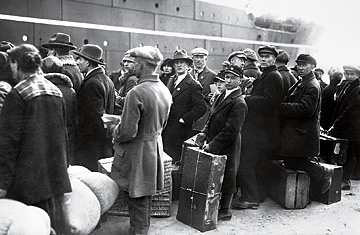
1927, Warsaw, Poland - Polish immigrants in line at the immigration office waiting to have their passports checked and their luggage examined before leaving.
As Congress takes another pass at immigration, its supporters hail it as an all-American phenomenon. President George W. Bush calls it therapeutic: "Immigration helps renew our soul. It helps redefine our spirit in a positive way." From Emma Lazarus' poem on the base of the Statue of Liberty, welcoming "huddled masses," to yesterday's naturalization ceremonies, immigration is as American as apple pie. But so, historically, is opposition to immigration. And while that opposition has often been infused with bigotry, it has also reflected reasonable concerns.
The bigotry of immigration opponents is a familiar shadow in our civic myth, like the devils and tempters in a medieval morality play. In 1798 John Adams signed the Alien Act, which gave the President the power to expel "dangerous" foreigners. Harrison Gray Otis, an Adams supporter in Congress, singled out "hordes of wild Irishmen" as particularly unwelcome. Other Congressmen mocked the French accent of Representative Albert Gallatin, who was born in Geneva, Switzerland. Adams was rewarded for his harshness on this issue and others by losing the election of 1800 to Thomas Jefferson, who understood Gallatin well enough to make him Treasury Secretary.
The next wave of anti-immigrant feeling targeted Irish and German Catholics. In 1844 anti-immigrant rioters in Philadelphia burned two Catholic churches. By the mid-1850s, an anti-immigrant political movement, the Know-Nothings (so-called because their organization was secret), seemed poised for national success. Abraham Lincoln disdained them: "How can any one who abhors the oppression of Negroes be in favor of degrading classes of white people?" The onset of the Civil War threw the Know-Nothings into the shade; the U.S. had enough homegrown trouble without worrying about immigrants.
In the early 1920s, Congress created a system of immigration quotas based on countries of origin, weighted toward northwestern Europe. "The races from Southern and Eastern Europe," a lobbyist argued, had no experience of government other than "paternal autocracy." The great immigration contraction coincided with a nationwide revival of the Ku Klux Klan, which, in this incarnation, was as much anti-Catholic and anti-Jewish as antiblack. The Klan's power peaked at the Democratic Convention of 1924, when pro-Klan forces battled for almost 100 ballots to keep New York's Catholic Governor Al Smith off the ticket. Smith managed to get nominated in 1928, only to be buried by Republican Herbert Hoover.
Yet immigration opponents in each of these periods had their reasons as well as their prejudices. In the late 1790s France and Ireland suffered revolutionary turmoil. French diplomats had interfered in U.S. politics. It seemed possible, as Otis warned, that some immigrants intended "to come here with a view to disturb our tranquillity." In the early 19th century, the Catholic Church in Europe won no favors in the U.S. by opposing republican revolutions in Italy and Hungary. American Catholics had been good citizens; would new arrivals also be? The anti-immigrant reaction of the 1920s was a spasm of disgust with both European autocracies and European revolutionaries. Kings and emperors had caused World War I, and Bolsheviks were plotting new horrors. Most Americans wanted to wash their hands of the Continent and its people.
Immigration restrictionists typically underestimate the sheer gravitational power of American life. Immigration renews the immigrant more than it renews America. The Catholics who so worried the Know-Nothings became champion practitioners of democratic politics; in the 20th century, their descendants' devotion to religious and political liberty helped convert the worldwide Roman Catholic Church at Vatican II.
What is different about our situation now is the large number of illegal immigrants and the unparalleled ease of getting here, whether from next-door Mexico or anyplace with airports. A handful of immigrants may be dangerous in precisely the way Otis imagined; the alleged Fort Dix plotters are from Jordan, Turkey and the former Yugoslavia. The vast majority who come here looking for work may feel the renewing force of assimilation less if they live in a ceaseless stream of their compatriots.
Historically immigrants come to love the flag, Mom and apple pie. But immigration isn't the flag. It's a route to the American experience, and the traffic flow has always been an issue of debate.
